Explainer
- Explainer
- Middle East tensions
‘Arrogant powers’: How Iran takes aim at its sworn enemies
In April, when Iran launched its first direct attack on Israel, we explored how Tehran projects power in the region – and why it regards the United States as ‘the great Satan’.
For Iran to overtly strike Israel, launching hundreds of drones and missiles from its own soil, has escalated a shadow war between the two nations into outright hostilities.
For years Iran has sponsored terror and rebel groups in the region, including Hamas and Hezbollah. In return, Israel has struck at Iranian leadership, most recently killing two senior Iranian generals at an Iranian diplomatic compound in Syria.
Why are the two nations at each other’s throats? What is Iran’s role in the region? And is its government on its last legs?
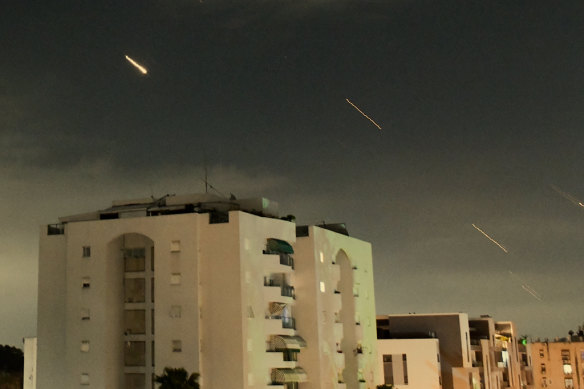
Israel’s Iron Dome air defence system launches in order to intercept missiles fired from Iran, in central Israel, on April 14, 2024. Credit: AP. digitally tinted
Why is Iran back in the spotlight?
For years, a “shadow war” has gone on between Iran and Israel. Israel, in part, has sought to thwart Iran regime’s ambitions to build nuclear weapons, its secret agents believed to be responsible for assassinating several Iranian nuclear scientists, including one by a remote-controlled machine gun. In February, Israel was implicated in the sabotage of two natural gas pipelines inside Iran, according to sources quoted in The New York Times.
Then, in early April, Israel seemed to change up a gear when its warplanes destroyed the Iranian consulate in the Syrian capital, Damascus, killing at least 11 people, including military top brass Mohammed Reza Zahedi, a commander in Iran’s elite Revolutionary Guards (more on them below), and senior commander Mohammad Hadi Haji Rahim.
It was a provocation that Iran’s Supreme Leader, Ayatollah Ali Khamenei, vowed would be revenged, foreshadowing the rocket and drone attacks that have stepped up the conflict. While the attacks caused little damage, in part because Iran telegraphed them ahead of time, what happens now hangs on whether Israel will feel compelled to respond or will show restraint, as world leaders have urged.
Until now, Iran had largely limited its threats against Israel to supporting militant and terror groups in the region, notably Hamas in Gaza. It also supports Hezbollah in southern Lebanon, the Houthis in Yemen and various militias and political parties in Bahrain, to whom it provides weapons, financial support and military training through the Revolutionary Guard and its foreign operations arm, the elite Quds Force. Iran is also “deeply involved” in the affairs of next-door neighbour Iraq, especially since the fall of Saddam Hussein in 2003, according to the Council on Foreign Relations.
It is an unusual arrangement in that the goals of the proxies do not always directly align with those of Iran or its Shia branch of Islam. “Iran is not particularly pious when it comes to which groups they’ll back,” says Ben Scott, a senior adviser at the National Security College at ANU. “They prefer to back groups that are more aligned to them, who are Shia if possible, but they’ll back whoever works. The most prominent non-Shia proxy is definitely Hamas because Hamas is Sunni Arab. It hasn’t been a straightforward relationship, as it has been with Hezbollah [which is Shia].”
Sunni Islam is the largest branch of Islam, followed by most of the world’s Muslims, including those in Saudi Arabia, making it the largest religious denomination in the world. Shia Islam is the second-largest branch of Islam and is the dominant form of the faith in Iran, Iraq and Azerbaijan. The differences between Sunni and Shia Muslims emerged after a disagreement over the succession to the Prophet Muhammad.
‘Plausible deniability is a big part of their approach. All that feeds into the idea of building up this network of partners and proxies through the region ...’
Was Iran responsible for the Hamas attacks on Israel on October 7? “We can’t fully attribute Hamas’s attack on Israel to Iran,” says Kylie Moore-Gilbert, an Australian-British academic in Middle Eastern political science. “But I do think that the link there is that after an unprecedented wave of mass protests following the death of Mahsa Amini [the young woman detained by Iran’s morality police allegedly for not wearing the hijab], Iran’s leaders decided the best form of defence is offence. The Iranian regime feels very much under siege at the moment, and the Gaza war deflects attention away from its internal instability.” Moore-Gilbert was famously detained by the regime for 804 days and now advocates for other hostages and activists within Iran.
“Plausible deniability is a big part of their approach,” says Scott. “All that feeds into the idea of building up this network of partners and proxies through the region, which you can use to carry out these battles elsewhere to attack US, Israeli and Gulf Arab states.”
Whether or not Iran was consulted ahead of the October 7 attacks, the result was to the regime’s benefit, say experts we spoke with, at least initially, because it derailed diplomatic attempts to improve relations between Israel, an avowed enemy, and Saudi Arabia, a US ally and a regional rival. Iran and the Saudis are on opposing sides in the civil war in Yemen, where Saudi Arabia supports the ousted government, and Iran supports the Houthi regime.
According to the Carnegie Endowment for International Peace, the Hamas attack “shattered Israelis’ sense of security in a heavily militarised country, removed the possibility of Saudi-Israeli normalisation for the foreseeable future, and demonstrated the cohesion of various Iran-backed non-state actors that challenge the regional status quo”.
Iran says it does not want all-out war with the United States or Israel, but neither does it exactly want peace. Iran’s issue with Israel is twofold, says Alam Saleh, lecturer in Iranian Studies at the Australian National University, currently in the UK. “It’s ideological on one hand and also about security.”
The US, too, has recently stepped up its attacks on Iran’s interests. In February, its B1 bombers hit more than 85 targets in Iraq and Syria, targeting both Iran’s Islamic Revolutionary Guard and its proxies, in response to a drone strike that killed three US soldiers in Jordan on January 28. The US has imposed punishing trade sanctions on Iran since 1979 and in more recent years in response to Iran’s nuclear program.
Meanwhile, the Houthis, a rebel group that emerged in the 1990s in northern Yemen, have harassed military and commercial shipping passing through a pinch point on its way to the Suez Canal in response to the war in Gaza. “Again,” says Scott, “there’s a debate about Iran’s command and control. It’s fair to say it’s much looser when it comes to the Houthis.” In February, the group’s missile attack on a British-owned bulk carrier forced the crew to abandon ship. The Houthis also took hostage 25 crew from a ship they hijacked in November 2023.
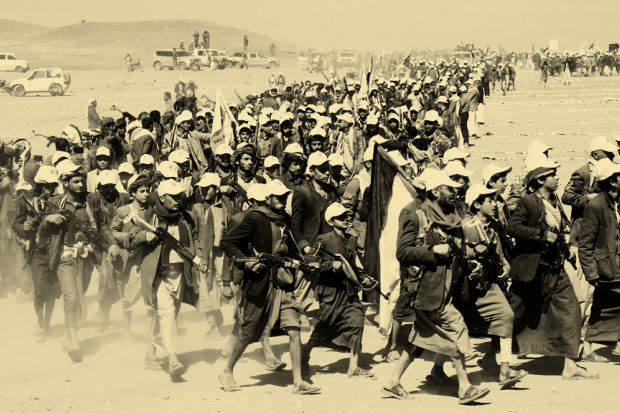
Houthi fighters rally in support of Palestinians in the Gaza Strip and against the US strikes on Yemen in a march outside the capital, Sanaa, in January. Credit: AP, digitally tinted
How did Iran go from rule by a Shah to ayatollahs?
Iran sits at the crossroads of Asia and the West, once the hub of the Silk Road trading route. “Even before oil, gas and other minerals were discovered in substantial quantities in the 20th century,” writes historian Ali Ansari in his new book Iran, “European statesmen were acutely aware of the geopolitical significance of the area.” Today, Iran borders some of the world’s most volatile regions, including Afghanistan and Iraq, stretching from Pakistan in the east to Turkey in the north. Just across the Persian Gulf are the oil and gas-rich states of the United Arab Emirates and Saudi Arabia; Israel is a day’s drive away (border police and bandits permitting) via Iraq and Jordan.
And while Iran, or Persia as it is still sometimes called, is somewhat reduced in prestige since the glory days of its ancient rulers, Iranians like to proudly recall how their nation was a crucible for magnificent cultures that outshone anything in the relatively barbaric West. Take Isfahan, Iran’s one-time capital, built in the 1600s at mind-boggling expense by the Safavid ruler Abbas the First. It was a city of such beauty – intricately tiled mosques, soaring minarets, grand boulevards and water gardens sprinkled with rose petals – that it remains a world heritage site capable of rivalling Angkor Wat for tourist pulling power.
We can trace Iran’s contemporary situation to many flashpoints, but we’ll go to 1953 and the event any Iranian simply calls “the coup”. In a nutshell, amid tensions over neocolonial oil revenues, Britain and the US assisted the military in overthrowing the elected prime minister, Mohammad Mosaddegh, and greatly empowered the Shah, Mohammad Reza Pahlavi.
The Shah’s rule, supportive of Western oil interests and US anti-communist ideology, was a mixed bag. For a time, the economy grew, and the nation modernised. But the Shah became increasingly despotic, allowing corruption to flourish, brutally suppressing dissent and indulging in extravagances that, by the 1970s, were stirring unrest, especially among left-leaning secularists, more conservative Muslims and those angered by land reforms that had inflamed social tensions.
Peak “Shah” came in 1971, when, to commemorate the 2500th anniversary of the Persian empire, he threw a lavish party in the ancient ruins of Persepolis (now also a world heritage site). Ingredients and staff came from Maxim’s of Paris: truffles, caviar, partridge, foie gras, and 2500 bottles of champagne poured into Baccarat crystals were just the start.
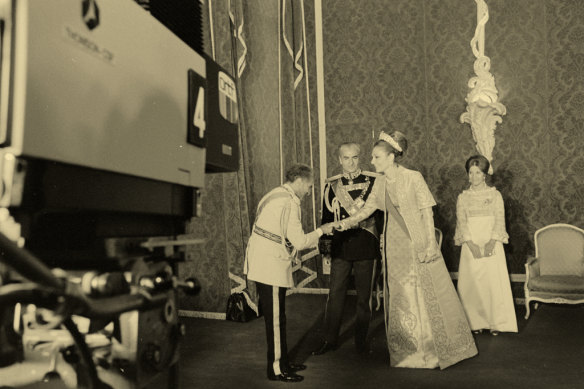
The Shah and Empress greet guests to their party in Persepolis in 1971.Credit: Getty Images, digitally tinted
The Shah, reported The New York Times, “was in full military uniform, his chest covered with medals. The Empress wore a green and white silk ball gown, although it was only 11 o’clock in the morning and long white gloves. Some of the emeralds in her 10‐pound [4.5 kilogram] crown were the size of golf balls.” Guests housed in a luxurious tent city included Princess Anne, Princess Grace (Kelly) of Monaco, the Ethiopian Emperor Haile Selassie, assorted Scandinavian royalty, Richard Nixon’s vice-president Spiro Agnew, and Romanian despot Nicolae Ceausescu. It was quite a gathering.
Missing from the party: the religious leader Ruhollah Musavi Khomeini, known as the face of Shia Islam, living in exile after being jailed twice for dissent. But he sent his regards. “Let them go all the way to Mars or beyond the Milky Way; they will still be deprived of true happiness, moral virtue and spiritual advancement and be unable to solve their own social problems.”
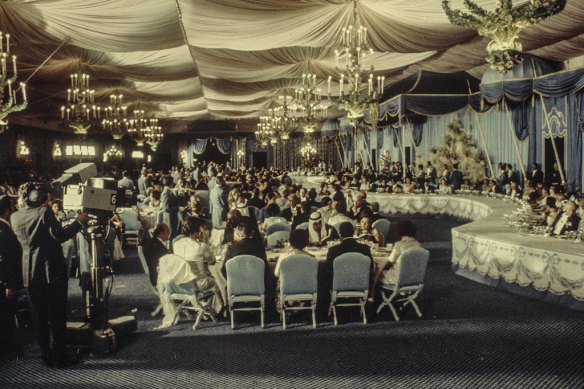
Guests enjoy champagne and foie gras in the banquet tent at the Shah’s 1971 party.Credit: Getty Images, digitally altered
By the mid-1970s, unrest was growing within Iran, fuelled by supporters of Khomeini. The economy began to falter. The Shah, diagnosed with cancer in 1974, then made a series of fatal missteps, including abolishing the multi-party democracy and arranging a bizarre newspaper article that claimed Khomeini was gay, a drug addict, a British spy and Indian not Iranian – which backfired by triggering violent protests. Efforts to quash these protests by force only inflamed the situation. By late 1978, the Shah’s behaviour was increasingly erratic. A televised flip-flop, in which he promised to listen to protesters’ demands, fell on deaf ears. In January 1979, he fled the country with his family, never to return.
Two weeks later, Khomeini returned to Tehran on a chartered Air France Boeing 747 packed with journalists. “Our culture has been despotism and colonialism,” he declared once he’d made his way through ecstatic crowds, reported the Associated Press. “Everything we had has been thrown to the wind. He, the Shah, has made the army follow the orders of another country”, apparently the United States.
Within weeks, Khomeini had sidelined the provisional government and held a referendum to abolish the monarchy in favour of a type of Islamic government that he himself had devised, based on the concept of “velayat-e faqih”, or “the rule of the jurist”. The referendum passed with 98 per cent of the vote. A new era had begun: that of the ayatollahs.
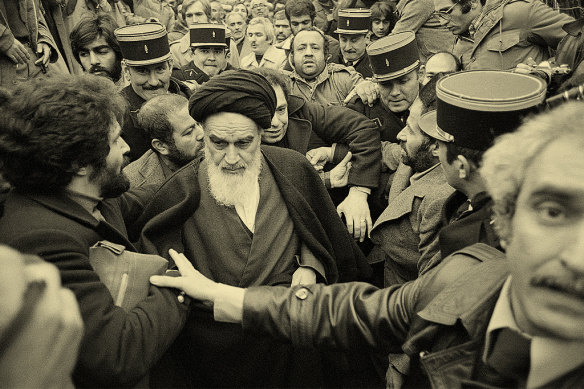
Ayatollah Khomeini in France in January 1979, just ahead of his return to Iran.Credit: Getty Images, digitally altered
Khomeini, who had offered the promise of a people-friendly democracy, quickly began governing with a much harder line than many of his early supporters had expected, particularly those on the left, whom he lost little time in purging. He would go on to give Islamic clerics almost complete power over government policy, imprison or execute dissidents, mandate that women wear the hijab headscarf, ban Western music, movies and alcohol and prohibit men and women from swimming or sunbathing together.
In 2013–14, British adventurer Lois Pryce took her motorcycle to Iran for a 4500-kilometre journey from Tabriz in the north to southern Shiraz. In her book Revolutionary Road, she recounts a visit to a once-bustling beach resort. “It was easy to see how the Caspian coast would have been the grooviest place to be before the revolution,” she writes, “but the last three decades had taken their toll.” She wondered “if I would ever in my lifetime see Iranians returning to these beaches in their bikinis and Speedos.”
Khomeini also put in place a new structure of government topped by himself as the supreme leader (who was also commander-in-chief of the armed forces) with a president below, an Assembly of Expert clerics and a Council of Guardians to decide who could run in parliamentary elections and which legislation should be struck out for not complying with sharia law. Khomeini and his successor, Ali Khamenei, are the only two men to have held the top job.
Reformist president wins elections in Iran
Iran’s president, Ebrahim Raisi, who was closely aligned with Supreme Leader Ali Khamenei, was killed in a helicopter crash in May 2024, triggering an election for his replacement. Disaffection with the ruling regime was attributed to 40 per cent voter turnout — the lowest since the 1979 revolution that saw the Shah ousted. Reformist candidate Masoud Pezeshkian, who opposes the enforced wearing of the hijab by morality police, led the results against a handful of hardliners. Pezeshkian, a heart surgeon and former health minister, then faced off in the second round against a conservative hardliner who was a former nuclear negotiator opposed to the nuclear accord with the United States. Pezeshkian’s slogan was Save Iran, and his stated aims included easing tensions with the West and reviving the nuclear deal. This time, 49 per cent of voters turned out. Pezeshkian won. But his ability to make a difference will be circumscribed by the other conservative hardliners in government and particularly the Supreme Leader’s powers.
The Islamic Revolutionary Guard Corps, separate from the regular military, is charged with protecting the state’s revolutionary regime. Today, it has fingers in many pies, wielding control over internal and border security, law enforcement, Iran’s ballistic missile program and “vast segments” of the economy, according to the Council on Foreign Relations, with interests in oil and gas projects, construction and telecommunications. Bahrain, Saudi Arabia, Sweden and the US consider the Guard a terrorist organisation. Its foreign espionage and paramilitary arm, the Quds Force, lost its top commander, Major-General Qassem Soleimani, to a US drone attack in Iraq in 2020.
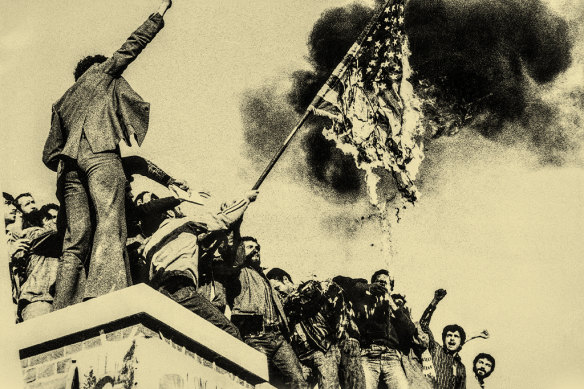
Protesters perched on a wall of the US embassy in Tehran burn an American flag during the hostage crisis of 1979. Credit: Getty Images, digitally tinted
Why does Iran have a problem with the United States?
“For many Iranians and certainly those in the Islamic Republic, the friction can be traced to 1953,” says Ali Ansari, professor at St Andrews University in Scotland and widely regarded as a world authority on Iran. He means the coup, of course, that the UK and the CIA helped orchestrate. Then there’s 1979, when, after the US granted asylum to the Shah, angry Islamic revolutionaries stormed the US embassy in Tehran, taking 52 US hostages. They were held for 444 days and released on January 20, 1981, just after Ronald Reagan had been sworn in as president. It was also in 1979 that Khomeini coined his memorable catchphrase: “[America is] the great Satan, the wounded snake.”
Fast-forward 45 years – past the Iran-Iraq war of the 1980s, past Khomeini’s fatwa on Salman Rushdie in 1989, past Iranians’ realisation that they had maybe not understood the Faustian bargain they had entered into with the revolution – and the great Satan is still enemy number one.
‘The arrogant powers refers to those villainous, aggressive, international forces that always want more and are never ever satisfied with what they have.’
Ahead of Iran’s legislative elections in 2024, Ali Khamenei said this: “Elections are a manifestation of the republican system, and this is why the arrogant powers and the US, who are opposed to both republicanism and the Islamic nature of the Islamic Republic, are against the elections and the enthusiastic participation of the people at the ballot boxes.”
Who are these “arrogant powers”? Khamenei again, from 2023: “The arrogant powers refers to those villainous, aggressive, international forces that always want more and are never ever satisfied with what they have. They observe, make plans, and see that they need to create a conflict in one place in order to profit in some other place.”
Then there are the ongoing US trade embargoes imposed since 1979 and now in a stalemate. In 2018, the US, under president Trump, walked away from a 2015 nuclear agreement known as the Joint Comprehensive Plan of Action, designed to limit Iran’s nuclear ambitions. Khamenei has said Iran will comply with the pact only if the US first lifts all of its sanctions. In February, the head of the International Atomic Energy Agency, Rafael Grossi, said Iran was enriching uranium almost at weapons grade, which belied its claims it was for civilian power production.
“Iran and the United States have many reasons not to trust each other,” says Saleh. “But it’s mainly about a power struggle. Iran is located in perhaps one of the most strategically important regions in the world, the Middle East. Therefore, Iran’s rise in power would not only undermine the United States and the Western interests in the region but also would be considered a threat by many of Iran’s neighbouring regimes. So nobody is happy in the region.”
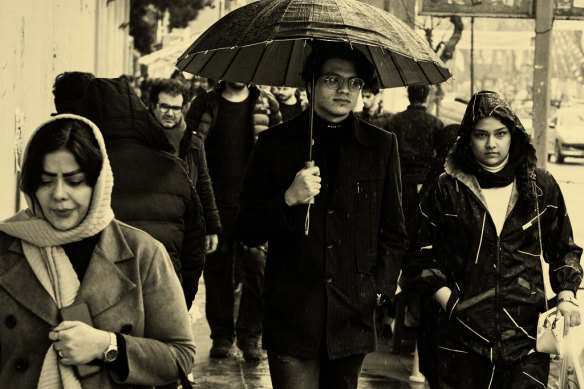
A rainy day in downtown Tehran in February 2024.Credit: Getty Images
What is life like in Iran today?
“Do not travel to Iran,” says the Australian government’s Smart Traveller site. Visitors can face “arbitrary detention or arrest” and kidnap for ransom. Don’t get caught up in demonstrations as “many protesters and bystanders have been injured, killed or detained”.
This might raise eyebrows among Iranians peacefully going about their daily business in Tehran’s Grand Bazaar or the famously lush gardens of Shiraz. “Having lived in both North America and Europe, I’ve never felt as safe as I do in Iran,” says an Iran-based photographer who asked us not to use their name. “The geopolitical issues in Iran, along with other topics covered by the news, represent only a narrow aspect of society. The media’s portrayal of Iran is often biased.”
Nevertheless, Iran’s domestic troubles appear to be escalating. While the mass protests of 2022 and 2023 have died down, support for the regime continues to wane as citizens tire of life inside a police state where the internet is slow and sites are blocked, prices rise much faster than wages – inflation is currently at around 40 per cent – and young people are leaving in droves. While we hear plenty about missiles and flag-burning, for normal Iranians, it’s the everyday irritations that grate.
“I used to enjoy going to cafes once a week, but it has become so expensive,” writes Kimia, a 23-year-old graduate student who kept a diary excerpted in The New York Times last year. “Now I can afford to go only once or twice a month. I can’t even download a movie or check social media properly with our stupid slow internet. Pretty much every application you want to use in Iran is blocked, and to get around the restrictions, we use virtual private networks. It takes hours.”
Lois Pryce’s book contains lively scenes where friendly Iranians treat her to illegal moonshine and boldly complain about the government. She has stayed in touch with friends she made then. “They’re incredibly spirited and refuse to be beaten,” she tells us from Spain. “Obviously, on a day-to-day level, they begrudgingly have to live their life, and most people do obey the dress code, begrudgingly, and they’re getting up to all the things they’re not allowed to do. Partying, drinking, playing in bands, watching films from America or reading books are all done behind closed doors, and there’s a certain element of enjoying the subversiveness, you know, that guilty feeling of getting away with something.”
Many women continue to defy mandatory hijab rules, blatantly or by wearing their headscarves “immodestly”. What risk are they taking? Says our local photographer: “I’m pretty certain that the women who decided not to wear their scarves during last year’s protests haven’t resumed wearing them – I’ve observed this through my daily encounters with friends and other women in the community. What’s interesting is that despite all the complications and challenges, I’ve noticed a gradual acceptance of these changes within society.“
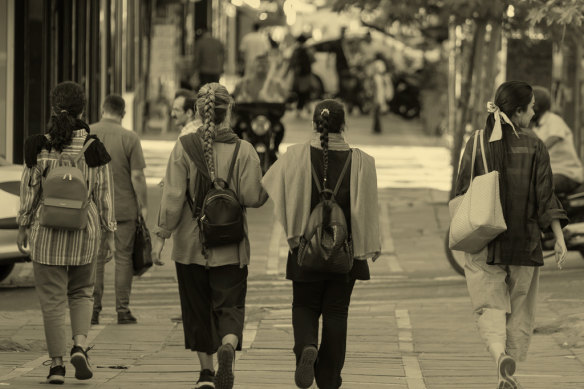
Young women on an avenue in downtown Tehran in September 2023.Credit: Getty Images, digitally tinted
How rigorously rule breakers are policed seems to be in flux. Reporters from US-based ABC News this month visited Tehran, where “plenty of women flouted the head covering rule, walking in public without a hijab”. Yet women are increasingly monitored by traffic cameras and vigilantes, who are encouraged to take pictures of offenders and send them to the authorities.
Says Kylie Moore-Gilbert: “There are still pockets of activism happening, and the authorities are trying to flex their muscles, make certain individuals into scapegoats and warn off anyone else from continuing their resistance on the streets.”
“The regime has run out of ideas and can only think of doubling down on a fossilised ideology,” says Ali Ansari. “I think it is on a steady spiral downwards.”
In 2023, a police spokesman said offenders would first be given a warning and then would have to face a judge; Iran’s deputy attorney-general warned that activists who encouraged others to appear bare-headed would be singled out. “The punishment for the crime of promoting and encouraging others to remove the hijab is much heavier than the crime of removing the hijab itself,” said Ali Jamadi, reported by the Mehr News Agency.
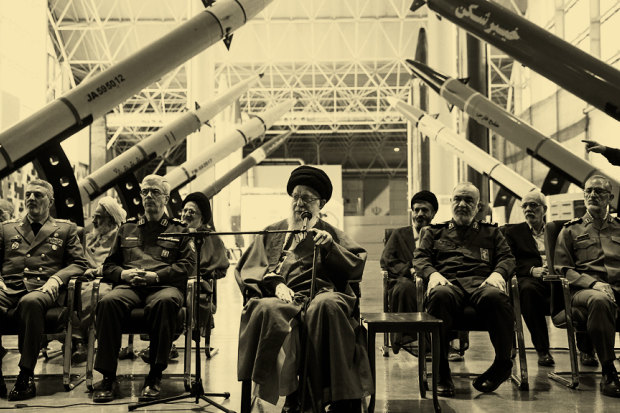
Iran’s Supreme Leader Ali Khamenei visits an exhibition of the Revolutionary Guard’s aerospace achievements in Iran in November. Credit: Office of the Iranian Supreme Leader via AP, digitally tinted
What is the outlook for Iran now?
It has been law to wear a hijab headscarf in Iran since the revolution in 1979. Since 2022, however, when Mahsa Amini, 22, died in hospital after being detained by Iran’s “morality police” for allegedly violating the mandatory dress code, the hijab has become a focus of both violent and silent protest that endures despite often brutal government reprisals. New laws will make wearing “inappropriate” clothing even more criminal, punishable by up to 10 years in jail.
“I don’t think reform has been on the cards for some time,” says Ansari. Moore-Gilbert agrees: “A lot of people are saying in Iran right now that none of the concerns raised during the Mahsa Amini protests were addressed. Many believe it’s only a matter of time before such a movement erupts again. There’s a lot of anger bubbling beneath the surface.”
Young people continue to leave, many as students. Many of the friends Lois Pryce made on her travels have left, she says, driven away by the cost of living and the repressive regime. “It does feel like this is a dark time that they’re living through right now,” she says.
The Financial Times reports that Iran “experienced the world’s fastest growth in the migration rate” to wealthy OECD countries between 2020 and 2021, according to OECD data, an increase of 141 per cent. The number of Iranians studying overseas has risen every year for the past eight years, according to a Tehran-based group called Iran Migration Observatory; meanwhile, asylum applications rose 44 per cent on the previous year, based on data from the UNHCR.
Regionally, says Ben Scott, we can expect Iran to keep pushing back against the United States. “Regime security is the highest priority of most governments,” he says. “For Iran, the main threat to national security, from their perspective, is the United States, which they see is bent on regime change.”
Meanwhile, Khamenei is 84 and believed to be not in the best of health, and has yet to name a successor. “Khamenei,” writes Ali Alfoneh for The Arab Gulf States in Washington website, “presumably wants to have his own preferred candidate succeed him, but he cannot publicly name a successor-designate without creating a rival and bringing about a dual power dynamic undermining his own authority.”
And yet. Our local photographer reminds us that life still goes on for ordinary folk in Iran, which remains, despite its troubles, a beautiful country rich in ancient culture. If you do get the chance ever to visit (despite the warnings), they say, “I would recommend immersing yourself in Iranian families. The interactions, social activities, gatherings, travels, foods, jokes, political discussions and other engagements are what truly make Iranians unique. Simply walking on the streets allows you to feel the presence of culture, history, art, and poetry in daily Iranian life.”
– with Maher Mughrabi
This explainer was first published in February 2024 and has since been updated to reflect developments.
Get fascinating insights and explanations on the world’s most perplexing topics. Sign up for our weekly Explainer newsletter.
Let us explain
If you'd like some expert background on an issue or a news event, drop us a line at explainers@smh.com.au or explainers@theage.com.au. Read more explainers here.